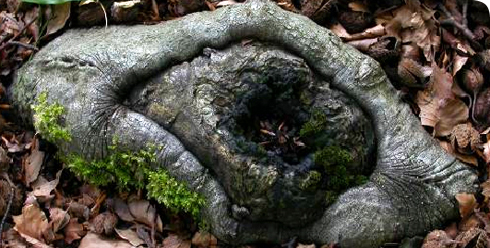Distribution and ecology
This species has a wide range but within this range is always extremely rare. Its abundance is dictated by the rare availability of suitable habitat.
Classified as oceanic sub-Mediterranean in distribution, this species occurs as far north as Denmark, down through Germany (particularly along the Rhine), Belgium (where possibly extinct) and France (where it is at its most abundant) and is then scattered throughout the Iberian peninsular.
To the east there are old records from Switzerland and northern Italy, but more recent finds from Croatia, Slovenia (2002), Greece, and one site in south-east Bulgaria. It is pan-Mediterranean, occurring on the Island of Sardinia and in the mountains of North Africa (Algeria and Morocco). On Madeira the probably conspecific Z. madeirensis is found.
Zygodon forsteri is a highly specialised epiphyte occupying a very narrow ecological niche. In the northern part of its range its host (phorophyte) is almost invariably Beech (Fagus sylvatica), although plants have been found on Quercus robur (once) and Acer campestre in the British Isles and on Ulmus spp. in continental Europe.
Further south and east it is most regularly found on other Oak species (Q. cerris, Q. faginea, Q. ilex, Q. mirbeckii, Q. rotundifolia), as well as on species of Populus, Ostrya and Juglans. In Southern Greece (Evvia) it grows on the conifer Abies cephalonica and has been found on A. pinsapo in Southern Spain.
In most cases the moss is closely associated with seepage lines from wound-tracks, or found in knot-holes, rot-holes and excrescenses on exposed roots. It does not persist on dead wood and would seem to be reliant on protracted wetness and a particular bark chemistry and even humic substances produced as a consequence of wounding, or seepage from damaged areas.
The known British distribution of knot-hole moss has historically been concentrated in three areas of pollarded Beech on acid gravels:
- Epping Forest (first found c.1790 at a woodyard in Walthamstow (TQ 39) - on timber taken from Monk’s Wood in Epping (TQ49))
- Burnham Beeches (SU 98)(first found 1902) and the New Forest (SU21)(first found 1954). It has apparently long been lost from single localities in Somerset -near Minehead, (SS 94) (31/3/1877, I. Gifford) where Holmes (1882) reported seeing it “on the top of an old stump behind a gate in a field”
- Near Harvington, Worcestershire (SP04), where it was known in very small quantity on a single veteran Acer campestre between 1905 and1910 (Amphlett & Rea ,1909).
Several other dubious or unlocalised specimens exist in herbaria from the southern coast of Britain (Proctor, 1961) which might indicate a still broader range last century, for example, material at BM from Chichester, W.Sussex (det. MCF Proctor) and Hastings, E.Sussex (see Holmes, 1882 for more contemporary comment on these). Holmes later reported this moss from “Urwell” (presumably Ulwell) in Dorset, a record which Hill & Edwards (2003) regard as “tantalizing” but regrettably inconclusive.
Proctor (1961) catalogued its British history on the occasion of its discovery in the New Forest, then the only known extant British site. Subsequently the species was rediscovered in the historic locations of Burnham Beeches (Little, 1967) and Epping Forest (Adams, 1984), from both of which it had remained unreported but presumably overlooked for over 50 years. It was found at a second New Forest site (Rockram Wood SU29,13) a few kilometres east of the first, by Neil Sanderson in 1993 (Brewis, Bowman & Rose, 1996) and has subsequently been found by him in 2005 in two other sites, near Wood Crates (SU 26,08) and in Stonards Wood (SU25,10).
Church et al. (2001), in the British Red Data Books: Mosses and Liverworts, summarised the history of records and reported the number of trees in each of the three areas supporting the plant. Counts from the 1990s suggested the plant might be present on 15 or fewer trees in Britain, with major losses having been noted following the severe storm of 1987. As a consequence the species was added to Schedule 8 of the Wildlife and Countryside Act, 1981 and such was the ongoing concern for the species’ survival that it was included as a priority species in the second tranche of the UK BAP process in 1999.
Subsequent survey work (Adams & Rumsey, 2004; Rumsey, 2005), which is continuing, has helped to reveal the true abundance of the plant and its population dynamics, such that threats may be better judged. This work has shown that, within the four areas of the New Forest where the plant is now known, 20 trees have supported the moss over the last ten years.
In Epping Forest the species was found on 67 trees during 2003-5 (Adams & Rumsey, 2005) while at Burnham Beeches 78 trees have supported the moss over the period 2004-8 (Woolner, Unpubl.).
